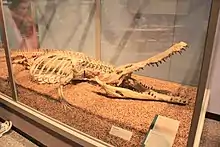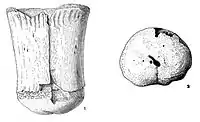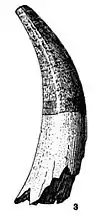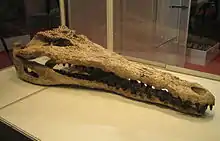Thecachampsa
Thecachampsa is an extinct genus of tomistomine crocodylian. Fossils have been found from the eastern United States in deposits of late Oliogcene to Miocene age. Those named in the 19th century were distinguished primarily by the shape of their teeth, and have since been combined with T. antiquus. More recently erected species were reassigned from other tomistomine genera, although their assignment to Thecachampsa has since been questioned.
| Thecachampsa | |
|---|---|
 | |
| T. carolinense skeleton | |
| Scientific classification | |
| Kingdom: | Animalia |
| Phylum: | Chordata |
| Class: | Reptilia |
| Order: | Crocodilia |
| Family: | Gavialidae |
| Subfamily: | Tomistominae |
| Genus: | †Thecachampsa Cope, 1867 |
| Species | |
| |
Description
Thecachampsa, like other tomistomines of the Oligocene and Miocene, was considerably larger than living crocodilians. Like living gharials, it had a long, slender snout. The teeth were long and recurved. Unlike its living relatives, Thecachampsa was marine, inhabiting estuaries and shallow coastal waters. Other marine fossils such as sea snail and bivalve shells, shark teeth, and barnacles have been found alongside remains of Thecachampsa and similar tomistomines.[1]
Species


In 1852 American paleontologist Joseph Leidy described Crocodylus antiquus from Miocene deposits in the Lee family's ancestral home in Virginia.[2] The holotype was a tooth found in the Calvert Formation of Virginia. Leidy also described additional material including several teeth and osteoderms, two vertebrae, a rib, and an ungual phalanx or claw bone. The new genus Thecachampsa was erected by Edward Drinker Cope in 1867, containing two species, T. sericodon and T. contusor, both also based on teeth, but no type species was designated.[3] Cope (1882) designated T. sericodon as the Thecachampsa type species.[4] T. sericodon was distinguished from T. antiqua by its slender, curved teeth, each with a sharp edge near the base of the posterior margin (T. antiqua only possessed sharp edges along a small area near the tip of the posterior margin).[1]
Crocodilian material found from Miocene deposits in the eastern United States has often been attributed to Thecachampsa, even isolated teeth with few distinguishable features.[5] In 1869, Cope named a fourth species, T. sicaria, from a jaw fragment and a dorsal vertebra. Unlike those of other species, the teeth of T. sicaria were lenticular (lens-shaped) in cross section with sharp cutting edges.[1] That year, Othniel Charles Marsh named another species of Thecachampsa, "T. squankensis", after the place of its discovery, Squankum, New Jersey, but that name is a nomen nudum because Marsh provided no description, diagnosis, or type specimen.[6] Cope named a new species, T. fastigiata, in 1870 as a reassignment of Crocodylus fastigiatus, named by Leidy in 1852.[7] These species were distinguished from one another primarily by differences in the shape of the teeth, the most common material found. The genus was synonymized with Crocodylus in 1973, but has since been regarded as valid.[8]
In 2001, A.C. Myrick synonymized Gavialosuchus americanus, another tomistomine from the eastern United States, with T. antiqua.[9] Myrick also synonymized Tomistoma lusitanica, a tomistomine from Portugal, with Thecachampsa. The genus name Thecachampsa had priority over the other two, as it was erected earlier. However, because the holotype tooth of T. antiqua has no clear diagnostic features to distinguish it from other tomistomines, later studies did not accept the synonymies.[10] Piras et al. (2007) considered G. americanus to be a member of the genus Thecachampsa, but placed it as a distinct species, T. americanus, rather than a synonym of T. antiqua.[11] The species was first described as Tomistoma americanus in 1915, with remains having been found from the Kirkwood Formation in New Jersey, the Calvert Formation in Maryland, the Chesapeake Group of Virginia, and the Pungo River and Yorktown Formations of North Carolina. Remains have also been found from Florida, California, Baja California, and, more recently, Costa Rica. Fossils of the species are present in deposits that range in age from the late Early Miocene to the early Pliocene.[12] More recent studies such as that of Jouve et al. (2008) have kept the species within Gavialosuchus, leaving T. antiqua as the only species within Thecachampsa.[13] However, Jouve et al. (2008) didn't test Thecachampsa antiqua in their phylogenetic analysis. Shan et al. (2009) found that G. americanus and G. eggenburgensis are not sister taxa. However, they didn't include T. antiqua and G. carolinensis in their analysis.[14] Christopher A. Brochu and Glenn W. Storrs (2012) tested all four species, alongside other crocodyloids, and found relatively strong support for Piras et al. (2007) suggestion. The cladogram below follows their analysis.[15]
.jpg.webp)
| Crocodyloidea |
| |||||||||||||||||||||||||||||||||||||||||||||||||||||||||||||||||||||||||||||||||||||||||||||||||||||||||||||||||||||||||||||||||||||||||||||||||||||||||||||||||||||||||||||||||

In addition to reassigning G. americanus and G. carolinensis to Thecachampsa, Myrick combined all previously named species of Thecachampsa in a single species, with the oldest name being T. antiqua. The different tooth shapes that distinguished the species were considered variation in the dentition of a single species.[9] However, the variation in dentition could only be seen in complete tomistomine skulls, all of which had been referred to Gavialosuchus before the genus was synonymized with Thecachampsa.
Weems (2018) agreed with Piras et al. (2007) and Brochu & Storrs (2012) that Tomistoma americanus and Gavialosuchus carolinensis belong to Thecachampsa rather than Gavialosuchus, but treated sericodon and antiqua as distinct species rather than one species, and noted that the americanus holotype is conspecific with T. sericodon, making T. americanus a synonym of T. sericodon. In addition, it found champsa to be an Egyptian word for “Crocodile” via Greek, and is a Masculine noun. Therefore, the spelling T. antiquus rather than T. antiqua is preserved.[16]
References
- Cope, E.D. (1871). "Crocodilia". Synopsis of the Extinct Batrachia and Reptilia of North America. Transactions of the American Philosophical Society. American Philosophical Society. pp. 61–82.
- Leidy, J. (1852). "Description of a new species of crocodile from the Miocene of Virginia". Journal of the Academy of Natural Sciences of Philadelphia. 2: 135–138.
- Cope, E.D. (1867). "Note on Thoracosaurus brevispinus". Proceedings of the Academy of Natural Sciences of Philadelphia. 19: 39.
- Cope, E. D. 1882. The Reptiles of the American Eocene. American Naturalist, 16:979–993. https://doi.org/10.1086/273224.
- Holman, J.A. (1998). "Geology and paleontology of the lower Miocene Pollack Farm Fossil Site, Delaware". In Benson, R.N. (ed.). Delaware Geological Survey Special Publication No. 21. pp. 141–147.
- Marsh, Othniel C. (1869). "Notice of some new reptilian remains from the Cretaceous of Brazil". American Journal of Science. 47 (141).
- Spamer, E.E.; Daeschler, E.; Vostreys-Shapiro, L.G. (1995). A Study of Fossil Vertebrate Types in the Academy of Natural Sciences of Philadelphia: Taxonomic, Systematic, and Historical Perspectives. Philadelphia: Academy of Natural Sciences. p. 120.
- Steel, R. (1973). "Crocodylia". Handbuch der Paläoherpetologie. 16. Stuttgart: Gustav Fischer Verlag. p. 116.
- Myrick, A.C. (2001). "Thecachampsa antiqua (Leidy, 1852) (Crocodylidae: Thoracosaurinae) from fossil marine deposits at Lee Creek Mine, Aurora, North Carolina, USA". Smithsonian Contributions to Paleobiology. 90: 219–225.
- P.A., Meylan; Auffenberg, W.A.; Hulbert, R.C. (2006). "The Fossil Vertebrates of Florida Book: Other Additions and Corrections". Florida Museum of Natural History Vertebrate Paleontology. Retrieved 26 November 2010.
- Piras, P.; Delfino, M.; Del Favero, L.; Kotsakis, T. (2007). "Phylogenetic position of the crocodylian Megadontosuchus arduini and tomistomine palaeobiogeography" (PDF). Acta Palaeontologica Polonica. 52 (2): 315–328.
- Laurito, C.A.; Valerio, A.L. (2009). "The first record of Gavialosuchus americanus Sellards (1915) (Eusuchia: Crocodylidae, Tomistominae) for the Late Tertiary of Costa Rica and Central America" (PDF). Revista Geólogica de América Central. 39: 107–115. ISSN 0256-7024. Archived from the original (PDF) on 2011-07-18.
- Jouve, S.; Bardet, N.; Jalil, N.-E.; Suberbiola, X.P.; Bouya, B.; Amaghzaz, M. (2008). "The oldest African crocodylian: phylogeny, paleobiogeography, and differential survivorship of marine reptiles through the Cretaceous-Tertiary boundary". Journal of Vertebrate Paleontology. 28 (2): 409–421. doi:10.1671/0272-4634(2008)28[409:TOACPP]2.0.CO;2.
- Shan, Hsi-yin; Wu, Xiao-chun; Cheng, Yen-nien; Sato, Tamaki (2009). "A new tomistomine (Crocodylia) from the Miocene of Taiwan". Canadian Journal of Earth Sciences. 46 (7): 529–555. doi:10.1139/E09-036.
- Brochu, C. A.; Storrs, G. W. (2012). "A giant crocodile from the Plio-Pleistocene of Kenya, the phylogenetic relationships of Neogene African crocodylines, and the antiquity of Crocodylus in Africa". Journal of Vertebrate Paleontology. 32 (3): 587. doi:10.1080/02724634.2012.652324.
- Robert E. Weems (2018). "Crocodilians of the Calvert Cliffs". Smithsonian Contributions to Paleobiology. 100: 213–240. doi:10.5479/si.1943-6688.100.
